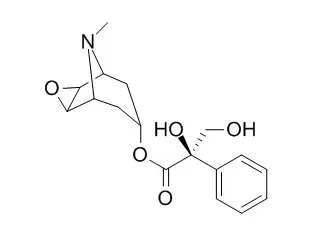| In vivo: |
| Eur J Drug Metab Pharmacokinet. 2015 Sep;40(3):245-53. | | Comparative study on pharmacokinetics of a series of anticholinergics, atropine, anisodamine, anisodine, scopolamine and tiotropium in rats.[Pubmed: 24748278] | The compound series of traditional anticholinergics [atropine (Atr), anisodamine (Ani), Anisodine (AT3), and scopolamine (Sco)], naturally occurring belladonna alkaloid, have been approved for numerous therapeutic uses since 1970s. Tiotropium, a novel M receptor antagonist for the treatment of chronic obstructive pulmonary disease, was structurally modified based on atropine-like drugs. Clinical phenomena suggested that the changes of substituent group were related to the pharmacokinetic and pharmacodynamic characteristics of the agents. In an attempt to compare the pharmacokinetics of the series of anticholinergics and investigate the subsets motivating selective anticholinergic potencies, a sensitive LC-MS/MS method was established to analyze the differences of pharmacokinetic parameters.
METHODS AND RESULTS:
In this paper, we determined the pharmacokinetics of atropine, anisodamine, Anisodine, scopolamine, and tiotropium after i.v. and i.g. single dose administration. After i.v. administration, the maximum drug plasma concentrations (C max) of Atr, Ani, AT3, and Sco were 274.25 ± 53.66, 267.50 ± 33.16, 340.50 ± 44.52, and 483.75 ± 78.13 ng/mL. Tiotropium had a slightly higher area under the curve with a significant increase of C max value. Because of their partial solubility, Atr, Ani, AT3, and Sco had different bioavailability in rats of 21.62, 10.78, 80.45 and 2.52 %, respectively. Following i.g. administration of tiotropium, the C max value below 20 ng/mL revealed the very low oral absorption. The urinary excretion rates of Atr, Ani, AT3, Sco and tiotropium were 11.33, 54.86, 32.67, 8.69 and 73.91 %.
CONCLUSIONS:
This work provided relatively comprehensive preclinical data on the series of anticholinergics, which may be used to explain the clinical adverse effects and applications. | | Zhejiang Da Xue Xue Bao Yi Xue Ban. 2011 Nov;40(6):659-62. | | Therapeutic effect of compound anisodine for primary open angle glaucoma.[Pubmed: 22190528] | To evaluate the therapeutic effect of compound Anisodine (CA) for patients with primary open angle glaucoma (POAG).
METHODS AND RESULTS:
According to the modified Hodapp-Parrish-Anderson Visual Fields Grading System, 46 patients with moderate stage POAG were randomized to receive compound Anisodine injection (CA group) or venoruton tablets (control group). Visual acuity (VA), IOP, fundus, visual fields (VF) and the blood flow of optic nerve were observed.
The mean of defect (MD) was decreased in CA group after treatment. The PSV and EDV of ophthalmic artery were remarkably improved in both groups, as well as the PSV, EDV and RI of retinal central artery. Compound Anisodine was superior in improving hemodynamics of ophthalmic artery and retinal central artery to venoruton.
CONCLUSIONS:
Compound Anisodine can protect optic nerve of POAG through improving the visual function and blood supply of optic nerve. | | Eye Sci. 2012 Mar;27(1):37-40. | | Efficacy of cytidine-5'-diphosp-bocholine combined with compound anisodine in the treatment of early optic nerve contusion.[Pubmed: 22447551 ] | To investigate the efficacy of Anisodine combined with cytidine-5'-diphosp-bocholine (citicoline) in the treatment of early optic nerve contusion.
METHODS AND RESULTS:
A total of 33 subjects eligible for inclusion were selected from 105 patients clinically diagnosed with optic nerve contusion. These patients were subsequently divided into the control group (n=16) and the intervention group (n=17). In the control group, the participants received therapy consisting of glucocorticoids, mannitol, vasodilators and vitamin B. The patients in the intervention group additionally received Anisodine in combination with citicoline. The visual acuity was graded on a scale from 0 to 8.
Prior to treatment, the 25th, 50th and 75th percentiles of visual acuity grade were 3, 4 and 6.75 for the controls, and 3, 4 and 6.5 for the patients in the intervention group. (P=0.97). After treatment, the 25th, 50th and 75th percentiles of visual acuity grade were 4, 6 and 7.75 in the control group, and 7, 7 and 8 in the intervention group. (P=0.046). A significant difference was observed in both control (P=0.005) and intervention groups (P=0.001) when comparing presenting visual acuity before and after treatment.
CONCLUSIONS:
The combination of Anisodine and citicoline with standard steroid and mannitol therapy appears to be effective in the treatment of early optic nerve contusion. |
|






 Cell. 2018 Jan 11;172(1-2):249-261.e12. doi: 10.1016/j.cell.2017.12.019.IF=36.216(2019)
Cell. 2018 Jan 11;172(1-2):249-261.e12. doi: 10.1016/j.cell.2017.12.019.IF=36.216(2019) Cell Metab. 2020 Mar 3;31(3):534-548.e5. doi: 10.1016/j.cmet.2020.01.002.IF=22.415(2019)
Cell Metab. 2020 Mar 3;31(3):534-548.e5. doi: 10.1016/j.cmet.2020.01.002.IF=22.415(2019) Mol Cell. 2017 Nov 16;68(4):673-685.e6. doi: 10.1016/j.molcel.2017.10.022.IF=14.548(2019)
Mol Cell. 2017 Nov 16;68(4):673-685.e6. doi: 10.1016/j.molcel.2017.10.022.IF=14.548(2019)